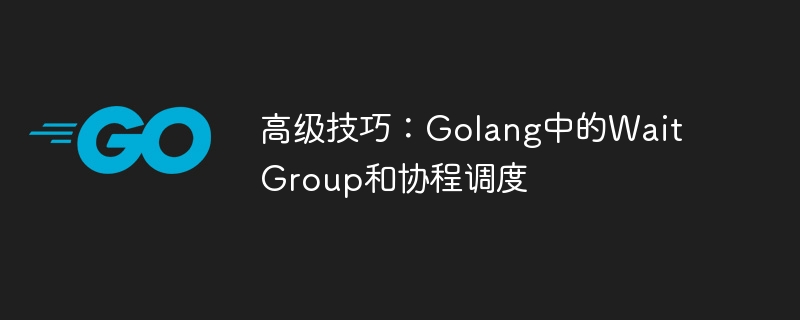Home >Backend Development >Golang >Advanced Tips: WaitGroup and Coroutine Scheduling in Golang
Advanced Tips: WaitGroup and Coroutine Scheduling in Golang
- 王林Original
- 2023-09-27 19:10:531351browse

Advanced skills: WaitGroup and coroutine scheduling in Golang, need specific code examples
Introduction
In Golang, coroutine (goroutine) It is a lightweight thread implementation that allows developers to easily perform multiple tasks concurrently. However, when dealing with concurrent tasks, we sometimes need to wait for all tasks to be completed before continuing to the next step. This requires the use of WaitGroup and coroutine scheduling. This article will introduce how to use WaitGroup and coroutine scheduling to handle concurrent tasks, with specific code examples.
1. The concept of WaitGroup
WaitGroup is a structure in Golang used to wait for a group of coroutines to complete. It provides three methods: Add(), Done() and Wait(). When we add a coroutine, use the Add() method to increment its count by one, and when the coroutine completes, use the Done() method to decrement the count by one. In the main coroutine, you can use the Wait() method to wait for all coroutines to complete.
The following is a simple example showing how to use WaitGroup:
package main
import (
"fmt"
"sync"
"time"
)
func main() {
var wg sync.WaitGroup
for i := 1; i <= 5; i++ {
wg.Add(1) // 增加一个协程的计数
go func(index int) {
defer wg.Done() // 在协程结束时减少计数
time.Sleep(time.Second * time.Duration(index))
fmt.Printf("协程 %d 完成
", index)
}(i)
}
wg.Wait() // 等待所有协程完成
fmt.Println("所有协程已经完成")
}In the above example, we used a loop to create 5 coroutines. In each coroutine, we use time.Sleep() to simulate a time-consuming operation. Here we use an index to identify each coroutine so that the execution order of the coroutines can be seen in the output. By calling wg.Add(1), we tell the WaitGroup to wait for a coroutine. Then, at the end of each coroutine, we use wg.Done() to indicate that the coroutine is complete. Finally, we use wg.Wait() to wait for all coroutines to complete.
2. Coroutine Scheduling
In the above example, we see that the execution order of the coroutine is not what we expect. This is because Golang's coroutine scheduler is non-deterministic, and the execution order between multiple coroutines is unpredictable. If we want coroutines to execute in a specific order, we need to use other methods to control the scheduling of coroutines.
In Golang, we can use channels to achieve synchronization and communication between coroutines. When a coroutine needs to wait for another coroutine to complete before continuing, the coroutine can be blocked on a channel until the other coroutine sends a completion signal. Here is an example that shows how to use channels to control coroutine scheduling:
package main
import (
"fmt"
"time"
)
func job(index int, done chan bool) {
time.Sleep(time.Second * time.Duration(index))
fmt.Printf("协程 %d 完成
", index)
done <- true // 发送完成信号到通道
}
func main() {
done := make(chan bool) // 用于接收完成信号的通道
for i := 1; i <= 5; i++ {
go job(i, done)
<-done // 阻塞等待协程完成
}
fmt.Println("所有协程已经完成")
close(done) // 关闭通道
}In this example, we define a function named job that accepts an index parameter and a done channel. In this function, we use time.Sleep() to simulate a time-consuming operation. At the end, we send a completion signal to the done channel to indicate that the coroutine has completed.
In the main function, we use a for loop to create 5 coroutines, and for each coroutine, we call the job function and pass in the done channel. Then, use
By using channels for coroutine scheduling, we can ensure that coroutines are executed in a specific order. In the above example, the execution order of coroutines is consistent with their index order.
Conclusion
This article introduces how to use WaitGroup and coroutine scheduling to handle concurrent tasks. By using WaitGroup, we can wait for a group of coroutines to complete. Using channels for coroutine scheduling can control the execution order of coroutines. These techniques are very useful when dealing with concurrent programming and can improve the performance and efficiency of your program.
Through example code and explanations, I hope readers can understand and apply these advanced techniques to better utilize Golang's concurrency features.
The above is the detailed content of Advanced Tips: WaitGroup and Coroutine Scheduling in Golang. For more information, please follow other related articles on the PHP Chinese website!

